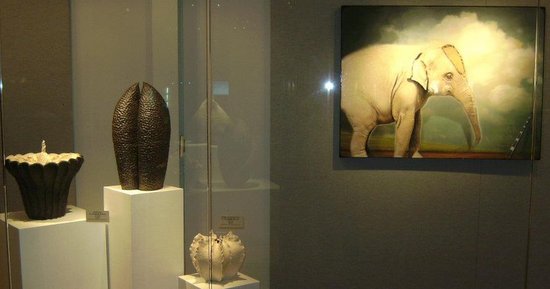
The phrase "the elephant in the room" is a metaphor for the obvious things we choose to ignore. In The Great White Elephant, Diane Naylor treats those words literally to explore our often contradictory, yet rarely acknowledged, relationship with the animal kingdom. Naylor's work presents our simultaneous tendency to idealize and dominate nature.
The painting is part of the current show - featuring 57 pieces by three local artists and running through April - at the Quad City Arts gallery inside the Quad City International Airport. Naylor's work is narrative and analytical, which creates a well-rounded exhibit when combined with the art of Elizabeth Shriver and Louise Rauh, who address nature with a focus on form rather than concept.
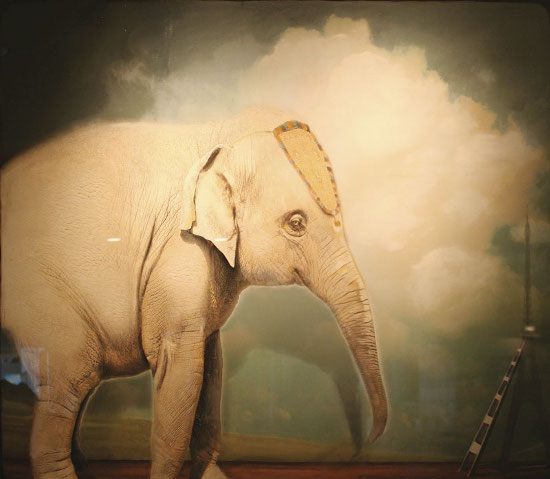
The bulk of Naylor's show is composed of mixed-media paintings, roughly four by three feet, that include animals in constructed settings. The Great White Elephant is exemplary of this style. An elephant with a circus-style headdress dominates the left side of the composition. It is in profile, in a casual standing pose, facing the right. The background is a blue sky with fluffy clouds over an empty landscape. Cleverly, Naylor has made it appear to be a backdrop, rather than a literal landscape, as the elephant is casting a shadow onto the "sky." In the bottom right corner is the Eiffel Tower, sans any sign of Paris. Leaning against the tower is a ladder.
Naylor's use of mixed media adds to the sense of staging. She has collaged a filtered photographic image of an elephant on top of her realistically painted clouds, but has rendered the ladder with thicker paint application. This causes a subtly disjointed quality, which works well with the content.
The elephant outside of its habitat should seem as jarringly out-of-place as the Eiffel Tower outside of Paris. Naylor compares the false homes animals are often placed in, such as the implied circus, to stage backdrops.
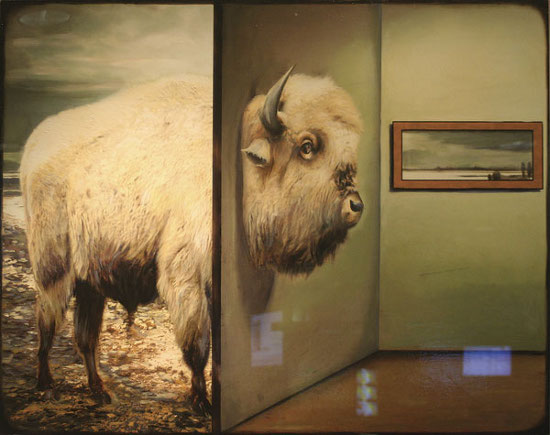
She makes a similar comparison in The Great White Buffalo. The composition is split in half by a cross-section of a wall. To the left of the divide is a buffalo's body standing on a shore. To the right is its head, appearing mounted on the wall. The left shows the natural existence of a buffalo, while the right shows humanity's appropriation of it into our habitat through its destruction. This is further stressed by a landscape painting hanging on the wall of the house - another example of nature in artifice.
This layering of symbolism adds initial intrigue to Naylor's art but at times seems vague or excessive. In The Great White Elephant, the ladder could mean progress or ascension. Elephants are associated with strong memories and bodies. The Eiffel Tower is identified specifically with France. The title's use of "white elephant" refers to a burdensome gift. The written quotes from philosophers on the side edges of her canvases add yet another layer. The use of so many potent, multifaceted symbols risks steering the viewer away from the central message.
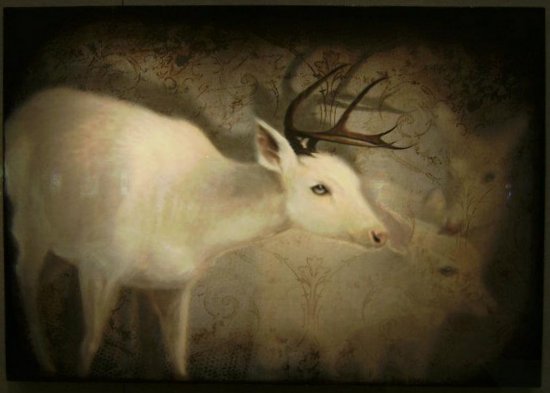
Loved Ones is an example of Naylor finding the happy medium. The subject is a white deer, viewed in partial profile from above eye level. It appears in mid-step, forming a diagonal as it seems to slowly walk across the canvas. The deer looks at the viewer with a shiny blue eye, forming a captivating focal point. A dark brown outer ring slowly fades into a white background, neatly containing the composition and establishing an ethereal tone.
Behind the deer, we see translucent overlapping figures of a fawn and doe, looking like ghosts, walking with the deer. The faint animals are overlapped by dark brown graphic elements, in patterned and natural motifs, giving the work a pleasant decorative feel.
This simple yet powerful message of loved ones lingering in our minds is usually a distinctly human theme. Applying it to animals supports Naylor's elevation of nature, while doing so in a relatable and visually appealing format.
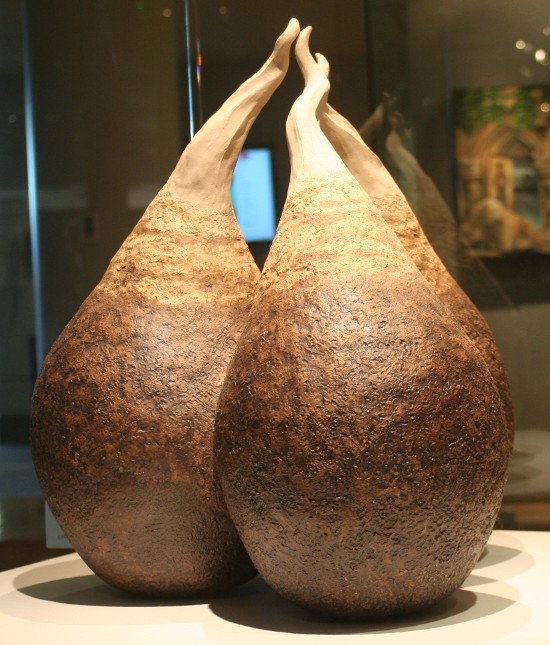
Elizabeth Shriver's ceramic sculptures resemble natural entities, such as coral or seeds, blown up in scale. Re-imagining tiny forms as three-foot-tall sculptures encourages us to get lost in the detail, texture, and subtle symmetry of the organic.
Triple Gourd Form with Tendrils seems natural but implausible. It looks like three gourds, attached at the center. The tops of the gourds look to be sprouting, forming three roots, reaching up and toward each other, faintly touching at the end.
Shriver provides incentive for the viewer to move around and view the sculpture from different angles by including various nooks of detail. When we look at Triple Gourd from the top, we can see that the gourds are hollow, with dozens of additional tiny tendrils filling their insides.
The outside texture is lumpy yet appealing in its naturalism. Rather than using glazes, Shriver has used stains and colored clay to achieve matte, earthy surfaces. Triple Gourd shows a masterful application of this technique, as the color fades from dark brown at the bottom to a pale tan at the apex.
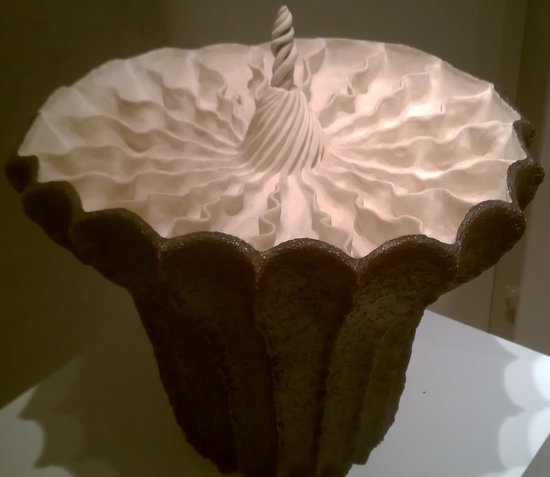
Shriver takes a more symmetrical approach in Large Floral Pod. This sculpture has a narrow base that expands into a flower-like opening. The top is full of wiggly lines, radiating from the center. The outside of the pod is dark brown, yet the interior is off-white. This stark contrast works well with the complex sculpted linework, softening the visual liveliness. Emerging from the middle is a fantastical spire of twisted coils, providing a visual endpoint to the upward and outward thrust of the composition.
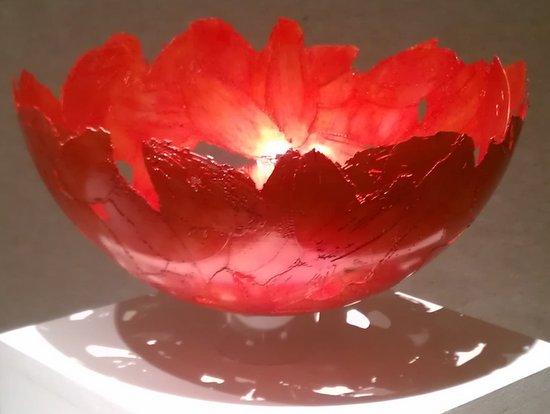
Louise Rauh heavily employs radial symmetry in her aluminum vessels. She uses a complex process, selectively applying areas of protective coating to aluminum bowls, then immersing them in a series of alkalines and acids before adding layers of acrylic ink for her vivid hues. Although Rauh's work reads more as craft than art, her vessels visually contrast organic textures with industrial material and color.
Red Petals is an example of this contrast. From a distance, Rauh has perfectly captured the texture and form of overlapping flower petals, with slight tears along the edges and bug-eaten holes in the centers. The shininess and intense, bright red color, however, make the bowl fanciful. This seemingly impossible form begs to be handled by the viewer; I found myself wanting to feel the contrast between the smooth outside and the irregular edge.
Rauh uses a similar visual and textural formula for Summer Rain but this time captures the impression of a distant tree line. The bottom of the vessel is whole, but it becomes riddled with small organic voids halfway up its height. About three-quarters of the way to the top, the voids become large, with only small bridges of green aluminum holding the rim to the rest of the bowl. At the top, the holes become smaller, with the remaining aluminum resembling treetops. This subtle abstraction takes the bowl beyond decorative, and shows the control Rauh has over her sculptural etching technique.
Michelle Garrison is a mixed-media artist who teaches art and design at Geneseo Middle School. She can be reached at michelle_m_garrison@hotmail.com.










